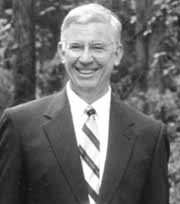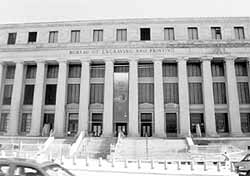
Dock of the Bay

Volume VII Number 2
January 14-20, 1999
Meet Your 'New' Governor: Glendening Gets Personal
In his first four years on the job, Gov. Parris
Glendening has been shy about disclosing the man behind the title. But as
he gets to know us better, he's getting bolder.
Running hard on the campaign trail last year, he began speaking of his family, revealing that his mother was addicted to Bingo. Last week, as he introduced his legislative plans for the new year, our five-year governor opened a deeper chapter of his family history.
Homosexuality was the subject.
In a soft and measured tone, the governor described the human story behind his policy decision to legislate against discrimination for sexual orientation:
"Some of you know that my brother was gay and died from AIDS. He was in the Air Force 18 years, served his country with distinction: three terms in Vietnam. He told me in the latter part of his life [his greatest fear] was not to die of AIDS but that throughout his tour of duty in the Air Force, he was so afraid that if anyone found out about his sexual orientation, he would be forced to leave the Air Force.
"No one should fear for their job because of their sexual orientation," said Glendening, vowing that "we will not permit discrimination on the basis of sexual orientation."
On another high priority, education, the governor soared on heart-felt currents of prose. Education, he said, "liberates the potential of the individual so that just about anyone can do anything they want." To prove his point, Glendening spoke again of his own experience:
"You know my story. I'm from a very poor family. I am here, having this really extraordinary, wonderful opportunity to help lead the state into the next century because of education."
Among the governor's new year's resolutions:
Try as he might to sound the sober note of policy, the governor could not repress his glee. He didn't even try too hard. The man who feared that Ellen Sauerbrey would end his political life was clearly "tickled to be here."
Fielding a softball on whether he took the terms of the election as a mandate from the voters, Glendening shared a conspiratorial glance with his lieutenant governor, Kathleen Kennedy Townsend, then ran away with the ball.
Triumphantly, Gov. Glendening numbered the terms of his victory: "Our 170,000 vote margin with increases in every single county in the state, with coattail effects in the legislature, with two new county executives on the same ticket, with five county commissioners turning from Republican to Democrat, with strong support on bipartisan bases, with a large number of independents …"
In the next four years, Marylanders can expect to be seeing more of their new, triumphant governor.
The Brightest Lights in Chesapeake
Country 
photo by Bill Lambrecht Curious
lights at night: Barges off of Poplar Island.
As we pack away our Christmas lights until next holiday
season, the brightest lights in Chesapeake Country shine on.
In mid-Bay, a band of brilliant spotlights burns long and bright. Their light is so intense that it reaches both Eastern and Western shores.
The 24-hour lights are inescapable, especially to sleepwalkers. They constantly beckon, drawing attention from otherwise misty days and black nights. They've got everybody wondering.
"Everybody asks me what they are," says David McCallum, whose Tilghman Island Inn on Knapp Narrows offers a direct view of the curious lights.
Those lights will still be radiating when darkness and light strike a
balance at the spring equinox. Maybe even until the summer solstice, when
winter's long dark is long forgotten.
The lights will probably "go until sometime in May," says Frank
Hamons, manager of Harbor Development for the Maryland Port Administration.
These are no stars of Bethlehem. The inescapable, powerful beacons are more prosaic signs that men are at work.
The work is restoring Poplar Island, an eroding four acres in the mid-Chesapeake one mile northwest of Tilghman Island. The Poplar Island Restoration Project will return the vanishing island - where Franklin Roosevelt once found seclusion - to its 17th century status of 1,110 acres. Over the centuries, the former island chain has been shrinking due to erosion and a rising sea level.
Sometime in the 21st century, however, Poplar Island will reemerge from the sea. The Maryland Port Administration, with its state and federal partners, will achieve this miracle by annually relocating 28 million cubic yards of clean, dredged sand and silt from Bay shipping channels to the island remains.
Over 20 years, the state of Maryland, the federal government and the U.S. Army Corps of Engineers will spend more than $400 million to rebuild the former refuge of presidents. For the Bay, it means habitat for wetlands and reef dwellers. For The Port of Baltimore, it means a close-by repository for dredged Bay bottoms and a healthier shipping economy.
It's in order to realize these benefits that the lights shine. The spots currently illuminate the worksite while Great Lakes, one of the project's many subcontractors, pumps and stockpiles sand from the worksite area.
As the work continues, giant barges act as barriers for the project site. They hold the earth-moving equipment, the lights themselves, and everything else the workers need to get the job done. The row of barges is akin to an off-shore oil drilling rig that acts as a home for around-the-clock activities of oil workers.
During this first phase of the project, workers will construct dikes made of sand, rock and stone. Later, during the dredging season from October to April, the dikes will receive and contain the sand and silt from shipping channels.
As long as work is underway, those lights may shine.
-Donna Ayres
This is Ayres' debut story as New Bay Times' intern.
 Bay Life - Thomas Harris: Our Man on the Money
Bay Life - Thomas Harris: Our Man on the Money
photos by Don Kehne Thomas
Harris, deputy director of the U.S. Bureau of Engraving.
Overseeing the making of gazillions
of dollars in U.S. currency, postal stamps and government securities requires
a rare conjunction of talents and skills: a printer's eye, a businessman's
savvy, a leader's wisdom - and Abe Lincoln's honesty. Where do you find
someone with that unlikely combination?
Meet Thomas Harris of Fishing Creek Farms on the South River: the newly appointed deputy director of the Bureau of Engraving and Printing. As deputy director, Harris manages daily operation of the Bureau's two printing plants in Washington, D.C., and Ft. Worth, Texas. In those two plants, all of the nation's currency and half of its postage stamps are produced.
While most of us might be tempted to take advantage of a position like
that - taking home a briefcase full of our work, for instance - Harris maintains
the most practical regard for what he does.
"It's a manufacturing job," says the 61-year-old Harris. "We're nothing more than a print shop. We just have a very special product."
Special, indeed. One look at pallets stacked high with shrink-wrapped bundles of his product - part of the 11.3 billion currency notes and over 20 billion stamps printed last year - sets the heart pounding and the blood rising.
For Harris, however, the new job is simply the logical next step in his 28-year career in the currency printing business - including 17 years spent with Bureau. In fact, Harris' pedigree - born into a family of printers in Washington, D.C. - suggests that he was destined for this job.
"There are only a few of us in the world who have these kinds of qualifications. It's a very narrow field," Harris acknowledges.
Among the more challenging tasks the new deputy director must oversee is the production of the newly designed bills, a process that began in 1996 with $100 bills, followed by $50 bills in 1997. Last year, it was those big-headed Andrew Jacksons: the new $20 bills. Smaller denominations will appear in 2000.
The new currency - the first major change since 1929 - aims to reduce the threat of counterfeit posed by the latest computer and printing technology, explains Harris. The new design incorporates publicized security features - such as watermarks, micro printing, color-shifting ink and imbedded threads - as well as covert features known only to the Treasury Department and Secret Service.
But no matter how well justified, the new look has not gone over well with the public.
"Yes, people say the new notes look like Monopoly money. We hear a lot of that," says Harris. For them, Harris keeps the play money handy for a true measure.
"But the collectors and dealers are the most upset," he allows. "They feel we have taken the aesthetic or visual value out of money by having too much white space and too little scrollwork."
Harris, however, gives the new money its due. "We feel the new design is a balance between functionality and aesthetics."
When not caught up in the daily press downtown, Harris enjoys home life on the Annapolis Neck Peninsula, where he and his wife have lived for the past five years.
"I've always been very, very fond of Annapolis. I spent a lot of time on Bay beaches in high school, and so did my wife. We always had a notion that Annapolis was where we wanted to be."
-Don Kehne
Many a boater has lamented the landlubbers on engines
that bound across the water at breakneck speeds near inlets and beaches,
endangering everybody on the water with their reckless abandon. 
Maryland Natural Resources Police have responded to complaints by making
speed limit changes in some high traffic areas.
Down in Deale, the Natural Resources Police reacted to petitions and extended
the existing six-knot speed limit 300 yards to Buoy 1 in Rockhold Creek.
That's to keep things civil in the congested, narrow channel.
A bit farther up the Bay in West River, DNR kept the existing weekend speed
limit of six knots/no wake and extended it about 200 yards in the area of
West River Yacht Club. The idea here is to keep the waters safe around the
club's southern docks and fuel pier.
In the waters of the upper Magothy River, the six-knot speed limit line
for Mill and Dividing Creeks has been nudged out another 100 yards to lessen
the danger for sunbathers on the public beach there. Speed demons who wanted
to fly as high as 35 knots down the congested river by day will be disappointed.
Be ready to slow down a bit come warm water. These changes take effect in
time for the 1999 boating season.
-Mark Burns
Second Call for Citizen Planners
Opportunity just knocked again.
So if your good intentions didn't answer the call last fall, when citizens in Southern and Western Anne Arundel County had their first chance to throw their names in the Small Area Planning ring, the new year brings a second chance.
The reason for your good fortune is the surprise election - days after the first deadline closed - of Janet Owens as county executive.
"The new county executive said 'why not just open the application process?'" said county spokesman John Morris, explaining the reopened door of opportunity.
The door stays open throughout the month of January, when everybody's plans to do better are fresh, shiny and unspoiled. So if you live in South County, Shady Side-Deale, Maryland City-Jessup, Linthicum-BWI, Odenton or Severn, you may have work to do.
It's work worth doing. In a process that's a little like convening a jury before the crime's committed, Anne Arundel County's small area planning brings 18 citizens to the table. There they apply the law - in this case, the county's new Long Range Plan - to real life. Real life, in this case, is how their communities will use their common space over the next quarter century. To fill or not to fill is, of course, one of the big questions.
The whole idea is to keep 'crimes' against our communities from being committed by using prudence, knowledge and compromise to plan ahead rather than using hindsight to look back in regret.
So use the next two weeks to take advantage of your second chance. Come February 1, your door of opportunity closes for good.
Then the applications work their way to Owens, who chooses 18 people for each committee. For guidance, she'll have the recommendations of a "qualifying committee" of citizens and county staffers - one committee for each area - who review and rank old and new applications. They base their recommendations on their own experienced judgment of the type who would do a good job.
"They use the old Sears rating system of 'good, better, best' plus not suitable, not a 1 to 18 ranking," explained Jody Vollmar, who organizes the county's review. Then all applications, organized by review category, go to Owens.
"No choices have been made. We're considering old and new together. She has not seen any yet," Morris wants you to know.
If there's no rush to judgment by the county, there's been no rush to apply by citizens, either. Vollmar says she's received only one new application, together with "eight or 10 more calls."
"I guess it's human character to wait till the last moment," she said.
Committee members will be announced in March to begin work in early April. New public forums to draw more citizens into the plan will be held in May and June.
Meanwhile, six earlier formed committees are nearing conclusion of their work, reviewing citizens' comments on their draft plans. Four of all 16 final committees will be formed next year.
-NBT
In Virginia, attitudes toward unwise development may be catching up with ours here in Maryland. A new poll from Virginia Commonwealth found that a solid majority favored tougher restrictions on growth: 70 percent of the 805 people surveyed said they preferred growth control over new roads. A bare majority even supported a tax increase to raise money to preserve farms, parks and woodlands …
In California, departing U.S. Rep. Frank Riggs (R), advocated pepper spraying of environmental protesters and held a spot on the 'Dirty Dozen' list of anti-green members of Congress. His new job might seem fitting to some: head of the company that sells a farm product called 'Slime Balls' …
St. Croix  preservationists
also don't think much of progress. They are fighting Texas-based Beal
Aerospace's drive to build a $70 million rocket assembly plant in the
Caribbean, the San Antonio Express-News reports …
preservationists
also don't think much of progress. They are fighting Texas-based Beal
Aerospace's drive to build a $70 million rocket assembly plant in the
Caribbean, the San Antonio Express-News reports …
In Thailand, Leonardo DeCaprio may be the movie boy heartthrob like everywhere else. But villagers contend that 20th Century Fox damaged coral reefs and removed native plants in November filming The Beach, an upcoming movie starring DeCaprio …
Our Creature Feature this week is a bovine
tale from Wisconsin. The Onion, the satirical, tongue-in-cheek
on-line magazine, reported that members of the animal group Animal Liberation
Front swept through the western part of the state last month, freeing
an estimated 71,000 cows from their servitude to the nation's dairy industry.
At last report, The Onion found all of the Cumberland Dairy Farm
Jersey cows standing around eating grass.
| Issue 2 |
VolumeVII Number 2
January 14-20, 1999
New Bay Times
Email New Bay Times
| Homepage |
| Back to Archives |